
Renault, a French automobile manufacturer, has been associated with Formula One as both team owner and engine manufacturer for various periods since 1977. In 1977, the company entered Formula One as a constructor, introducing the turbo engine to Formula One with its EF1 engine. In 1983, Renault began supplying engines to other teams. Although the Renault team had won races, it withdrew at the end of 1985. Renault engines continued to be raced until 1986.

Red Bull Racing, currently competing as Oracle Red Bull Racing and also known simply as Red Bull or RBR, is a Formula One racing team, racing under an Austrian licence and based in the United Kingdom. It is one of two Formula One teams owned by conglomerate Red Bull GmbH, the other being Scuderia AlphaTauri. The Red Bull Racing team has been managed by Christian Horner since its formation in 2005.

Nicolas Hülkenberg is a German racing driver who drives for the Haas F1 Team in Formula One. He was the 2009 GP2 Series champion, and is a previous champion of both the Formula 3 Euro Series and A1 Grand Prix, as part of A1 Team Germany. He is one of six drivers since 2005 to win the GP2 Series/Formula 2 championship in his debut season, the others being Lewis Hamilton, Nico Rosberg, Charles Leclerc, George Russell, and Oscar Piastri. Outside of Formula One, he won the 24 Hours of Le Mans in 2015 on his first attempt and also contested two rounds of the 2015 FIA World Endurance Championship season for Porsche.

Daniel Joseph Ricciardo is an Australian and Italian racing driver currently competing in Formula One for Scuderia AlphaTauri under the Australian flag. He has achieved 8 Grand Prix victories and 32 podiums in Formula One.

Kevin Jan Magnussen is a Danish racing driver currently competing in Formula One for Haas F1 Team.
Haas Formula LLC, competing as MoneyGram Haas F1 Team, is an American-licensed Formula One racing team established by NASCAR Cup Series team co-owner Gene Haas in April 2014. The team originally intended to make its debut at the start of the 2015 season but later elected to postpone their entry until the 2016 season. The team principal is Guenther Steiner.

The 2016 FIA Formula One World Championship was the 70th season of the Fédération Internationale de l'Automobile (FIA)'s Formula One motor racing. It featured the 67th Formula One World Championship, a motor racing championship for Formula One cars which is recognised by the sport's governing body, the FIA, as the highest class of competition for open-wheel racing cars. Teams and drivers took part in twenty-one Grands Prix—making for the longest season in the sport's history—starting in Australia on 20 March and finishing in Abu Dhabi on 27 November as they competed for the World Drivers' and World Constructors' championships.

The 2015 Italian Grand Prix was a Formula One motor race held on 6 September 2015 at the Autodromo Nazionale di Monza in Monza, Italy. The race was the twelfth round of the 2015 season, and marked the 85th running of the Italian Grand Prix.

The 2017 FIA Formula One World Championship was the 71st season of Formula One motor racing. It featured the 68th Formula One World Championship, a motor racing championship for Formula One cars which is recognised by the sport's governing body, the Fédération Internationale de l'Automobile (FIA), as the highest class of competition for open-wheel racing cars. Teams and drivers competed in twenty Grands Prix—starting in Australia on 26 March and ending in Abu Dhabi on 26 November—for the World Drivers' and World Constructors' championships.

The 2014 FIA Formula One World Championship was the 68th season of FIA Formula One motor racing. It featured the 65th Formula One World Championship, a motor racing championship for Formula One cars, recognised by the sport's governing body, the Fédération Internationale de l'Automobile (FIA), as the highest class of competition for open-wheel racing cars. The season commenced in Australia on 16 March and concluded in Abu Dhabi on 23 November. In the nineteen Grands Prix of the season, a total of eleven teams and twenty-four drivers competed for the World Drivers' and World Constructors' championships. It was the first Formula One season since 1994 to see an accident with ultimately fatal consequences as Jules Bianchi succumbed to the injuries he sustained during the 2014 Japanese Grand Prix. He died on 17 July 2015 after spending nine months in a coma following the accident.

The Renault R.S.16 was a Formula One racing car designed by the Renault Sport Formula One Team to compete in the 2016 Formula One season, and marked Renault's return to the sport as a constructor after a five-year absence.
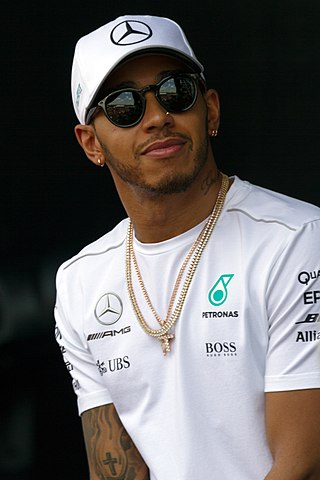
The 2018 FIA Formula One World Championship was the motor racing championship for Formula One cars and the 69th running of the Formula One World Championship. Formula One is recognised by the governing body of international motorsport, the Fédération Internationale de l'Automobile (FIA), as the highest class of competition for open-wheel racing cars. Drivers and teams competed in twenty-one Grands Prix for the World Drivers' and World Constructors' championship titles.
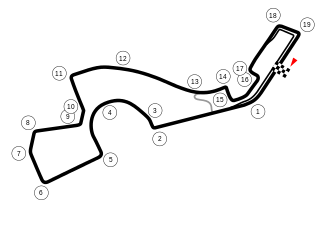
The 2017 Russian Grand Prix, officially known as the 2017 Formula 1 VTB Russian Grand Prix, was a Formula One motor race that took place on 30 April 2017 as the fourth round of the 2017 FIA Formula One World Championship. The fifty-two lap race was held at the Sochi Autodrom, marking the fourth running of the Russian Grand Prix as a round of the Formula One World Championship. Sebastian Vettel started the race from pole, with his teammate Kimi Räikkönen in second in Ferrari's first front-row lockout since the 2008 French Grand Prix. Valtteri Bottas won the race, taking his first win in Formula 1 by 0.617 seconds over Vettel, the smallest winning margin since the 2016 Abu Dhabi Grand Prix.
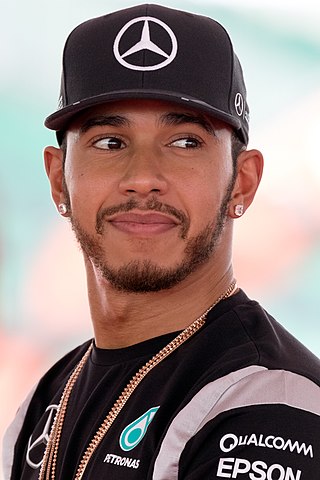
The 2019 FIA Formula One World Championship was the motor racing championship for Formula One cars which marked the 70th running of the Formula One World Championship. It is recognised by the governing body of international motorsport, the Fédération Internationale de l'Automobile (FIA), as the highest class of competition for open-wheel racing cars. Starting in March and ending in December, the championship was contested over twenty-one Grands Prix. Drivers competed for the title of World Drivers' Champion, and teams for the title of World Constructors' Champion. The 2019 championship also saw the running of the 1000th World Championship race, the 2019 Chinese Grand Prix.

The McLaren MCL33 is a Formula One racing car designed and constructed by McLaren to compete in the 2018 FIA Formula One World Championship. The car was driven by two-time World Drivers' Champion Fernando Alonso and Stoffel Vandoorne, with additional testing and development work carried out by reigning European Formula 3 champion Lando Norris and McLaren's regular test driver Oliver Turvey. The MCL33 is the first car built by McLaren to use a customer Renault engine after the team terminated its engine supply deal with Honda after three years and also first McLaren car to utilize a French-licensed engine manufacturer since the Peugeot-powered McLaren MP4/9 in 1994. It made its competitive debut at the 2018 Australian Grand Prix. The car was launched with an orange and blue livery designed as a tribute to some of the team's earliest cars. Currently Fernando Alonso’s MCL33 is on display at the Petersen Automotive Museum in Los Angeles, CA, USA.

The Sauber C37 is a Formula One racing car designed and constructed by Sauber to compete during the 2018 FIA Formula One World Championship. The car was driven by Marcus Ericsson and reigning Formula 2 champion Charles Leclerc, who replaced Pascal Wehrlein. The C37 made its competitive début at the 2018 Australian Grand Prix and uses a 2018-specification Ferrari engine. This was the last car to be raced under the Sauber name as they were renamed as Alfa Romeo for the 2019 season, although the team's structure has remained unchanged.
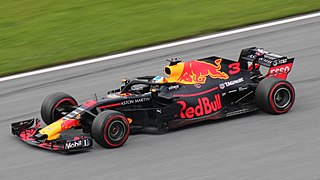
The Red Bull Racing RB14 was a Formula One racing car designed and constructed by Red Bull Racing to compete during the 2018 FIA Formula One World Championship. The car was driven by Daniel Ricciardo and Max Verstappen, and made its competitive début at the 2018 Australian Grand Prix. Like its predecessors the RB12 and RB13, the RB14 used a Renault engine badged as a TAG Heuer.
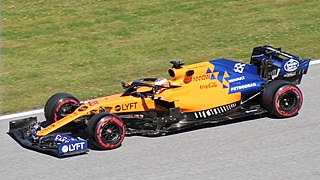
The McLaren MCL34 was a Formula One racing car designed by Pat Fry and constructed by McLaren to compete in the 2019 Formula One World Championship. The car was driven by Carlos Sainz Jr., who joined the team from the Renault Sport F1 Team; and 2018 Formula 2 Championship runner-up Lando Norris. Sainz Jr. and Norris replaced Fernando Alonso and Stoffel Vandoorne, both of whom left the team at the end of the 2018 championship. The MCL34 was powered by a Renault engine, the Renault E-Tech 19, and made its début at the 2019 Australian Grand Prix. The car was considered to be a big improvement compared to its disappointing predecessor, the MCL33, often being the best of the rest in qualifying and race trim behind the three leading teams: Mercedes, Ferrari and Red Bull.

Racing Point F1 Team, which competed as BWT Racing Point F1 Team and commonly known as Racing Point, was a British motor racing team and constructor that Racing Point UK entered into the Formula One World Championship. The team was based in Silverstone, England and competed under a British licence.

The Renault R.S.20 is a Formula One car designed by the Renault F1 Team to compete in the 2020 Formula One World Championship.



















